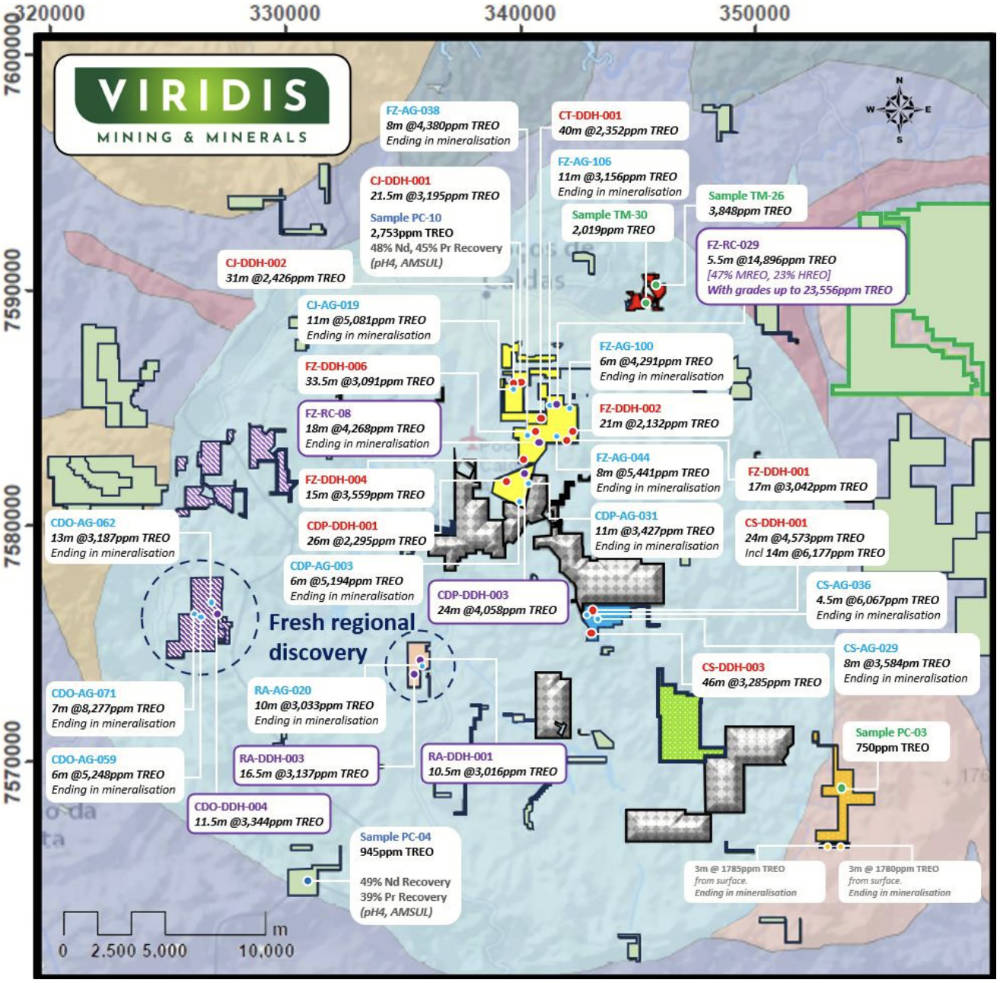Viridis looks lively as drilling returns 23,556ppm TREO, the highest yet in the entire complex

Viridis is breaking out in song and dance after making the highest ever REE intersection by any company within the Poços de Caldas Alkaline Complex to date. Pic via Getty Images
- Viridis reports its highest-grade REE intersection of 23,556ppm TREO at the Poços de Caldas Alkaline Complex to date
- Intercept also includes the highest levels of valuable dysprosium and terbium
- This area of the Fazenda mining licence is now a significant area of interest for the Brazil-focused company
- Further drill assays pending as exploration continues
Special Report: Fate appears to be squarely on Viridis Mining and Minerals’ side after maiden drilling within the Fazenda mining licence in Brazil uncovered a major high-grade zone and eye-popping intersections of up to 23,556ppm (2.36%) TREO.
Fazenda is part of the company’s Colossus ionic adsorption clay-hosted REE project located right next door to Meteoric Resources’ (ASX:MEI) 409Mt @ 2,626ppm total rare earth oxides (TREO) Caldeira project, the highest grade IAC project known globally with excellent leach extractions for valuable magnet REEs.
Viridis Mining and Minerals’ (ASX:VMM) maiden drilling at Colossus has already indicated that it might be competitive with its neighbour in terms of grade. This was highlighted in the third batch of assay results which returned an average grade of 3,002ppm TREO across 113 drill holes.
While IAC projects are much sought after due to their comparative ease of exploring, alongside mining and processing typically offsetting lower grades compared to their hard rock counterparts, it is still necessary to find deposits with the sufficient grade and the right characteristics.
Both VMM and MEI appear to have done exactly that with their respective projects and have rather strategically cut-off any juniors from joining them by grabbing all of available ground within the Poços de Caldas complex, in Brazil’s pro-mining state of Minas Gerais, not already held by the big players.

Outstanding drill assays
The fourth batch of assays from the maiden drill program has now delivered impressive results with the intersection of 18.5m @ 6,253ppm TREO from 1m in hole FZ-RC-29 being topped by that 23,556ppm TREO intersection over 1m sitting right at the top.
Notably, this intersection is the highest surface grade (both of overall grades and concentrations of dysprosium and terbium) reported by any company in the Poços de Caldas Alkaline Complex to date and highlights the exploration potential of Colossus.
Adding further interest, the high-grade portion itself has an impressive 5.5m @ 6,154ppm of valuable heavy rare earth oxide, which demonstrates an entire new potential for this area of the complex to predominantly produce the high-value and critical heavy rare earths – in particular dysprosium and terbium.
But wait, there’s more!
Maiden auger and diamond drilling at the Ribeirão prospect has also returned high-grade intersections topping up at 10m @ 3,033ppm TREO ending in mineralisation from 1m.
This represents a second breakthrough discovery at Colossus in as many months that will contribute to the definition of a maiden resource.
Meanwhile, assays from deeper diamond and RC drilling continue to showcase thick saprolite horizons mineralised in high-grade REE that improve the grade and tonnage potential at Colossus.
Notable intersections are 18m @ 4,268ppm TREO (36% magnet REOs) within a broader 31m zone @ 3,080 TREO from surface and 12m @ 6.039ppm TREO (32% MREO) within a broader 24m intersection @ 4,058ppm TREO from 11m.
Auger drilling has also returned widespread high-grade REE assays with drilling at Capão da Onça continuing to return exceptional grades above 6,000ppm.
“These results are truly staggering. This set of assays not only contains another greenfield discovery which will contribute to our maiden resource, but also contains the highest reported grade intercept at surface within the entire Poços de Caldas Alkaline Complex by any company,” VMM chief executive officer Rafael Moreno said.
“FZ-RC-29 is the best hit we’ve seen to date within Colossus, not only in terms of grade, but to have 47% MREO and a remarkable 23% HREO starting near surface completely changes the economic potential of this area.
“Nowhere else in the complex have we seen over 500ppm of dysprosium and terbium so close to the surface. This has resulted in Colossus holding a critically important position and project within the entire complex, with the first known mining licence to predominantly host HREO mineralisation within its basket.
“It’s the first time I’ve seen an ionic clay project report grades this high at surface with almost a quarter being mineralised in high-value HREO.”
Dysprosium and terbium fetch 5-10 times the value of neodymium and praseodymium, which are already valuable in their own right, making this area of Fazenda a significant area of interest for VMM.
“The latest batch of results continues to demonstrate that Colossus is yet to uncover its full potential. With aggressive exploration, we continue to make discoveries at depth and in new areas,” Moreno added.
More than 100 assays still pending
VMM still has over 100 drill holes pending assays with aggressive exploration ongoing.
It is also making the full transition from auger to deep RC/diamond drilling which is expected to produce thicker intercepts.
Auger drilling will continue for greenfield exploration work to scout new areas of interest and has already commenced in new areas comprising the recent strategic expansion of Colossus.
This article was developed in collaboration with Viridis Mining & Minerals, a Stockhead advertiser at the time of publishing.
This article does not constitute financial product advice. You should consider obtaining independent advice before making any financial decisions.
Related Topics

UNLOCK INSIGHTS
Discover the untold stories of emerging ASX stocks.
Daily news and expert analysis, it's free to subscribe.
By proceeding, you confirm you understand that we handle personal information in accordance with our Privacy Policy.








